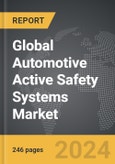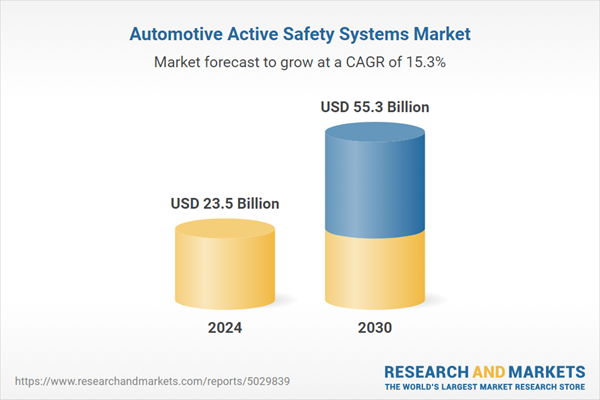The global market for Automotive Active Safety Systems was valued at US$23.5 Billion in 2024 and is projected to reach US$55.3 Billion by 2030, growing at a CAGR of 15.3% from 2024 to 2030. This comprehensive report provides an in-depth analysis of market trends, drivers, and forecasts, helping you make informed business decisions. The report includes the most recent global tariff developments and how they impact the Automotive Active Safety Systems market.
Segments: Product (Anti-Lock Braking Systems (ABS), Adaptive Cruise Control Systems (ACC), Lane Departure Warning Systems (LDWS), Electronic Stability Control (ESC) Systems, Other Products); End-Use (Passenger Cars, Commercial Vehicles).
Geographic Regions/Countries: World; United States; Canada; Japan; China; Europe (France; Germany; Italy; United Kingdom; Spain; Russia; and Rest of Europe); Asia-Pacific (Australia; India; South Korea; and Rest of Asia-Pacific); Latin America (Argentina; Brazil; Mexico; and Rest of Latin America); Middle East (Iran; Israel; Saudi Arabia; United Arab Emirates; and Rest of Middle East); and Africa.
The analysts continuously track trade developments worldwide, drawing insights from leading global economists and over 200 industry and policy institutions, including think tanks, trade organizations, and national economic advisory bodies. This intelligence is integrated into forecasting models to provide timely, data-driven analysis of emerging risks and opportunities.
Global Automotive Active Safety Systems Market - Key Trends and Drivers Summarized
What Are Automotive Active Safety Systems and Why Are They Crucial?
Automotive active safety systems have become an integral part of modern vehicles, playing a critical role in preventing accidents and enhancing road safety. Unlike passive safety systems, which protect occupants during a collision, active safety systems are designed to prevent accidents from occurring in the first place. These systems use a combination of sensors, cameras, radar, and software algorithms to monitor the vehicle’s surroundings and assist the driver in avoiding potential hazards. Examples of active safety systems include Automatic Emergency Braking (AEB), Lane Keeping Assist (LKA), Adaptive Cruise Control (ACC), and Blind Spot Detection (BSD). These technologies work by continuously assessing the driving environment and intervening when necessary, such as applying the brakes to avoid a collision or providing steering input to prevent the vehicle from drifting out of its lane. The integration of these systems is becoming increasingly common as automakers and regulators alike recognize the importance of proactive safety measures in reducing traffic accidents and saving lives.How Do Automotive Active Safety Systems Enhance Driving Experience?
Automotive active safety systems significantly enhance the driving experience by reducing the cognitive load on drivers and providing real-time assistance in complex or potentially dangerous situations. For instance, Adaptive Cruise Control (ACC) not only maintains a set speed but also adjusts the vehicle’s speed based on the traffic ahead, allowing for a smoother and more controlled driving experience on highways. Similarly, Lane Keeping Assist (LKA) helps drivers stay within their lane by providing corrective steering inputs if the vehicle begins to drift, reducing the likelihood of unintentional lane departures, which are a common cause of accidents. Blind Spot Detection (BSD) alerts drivers to vehicles in their blind spots, helping to prevent collisions during lane changes. These systems are especially beneficial in urban environments where traffic density is high, and the risk of accidents is greater. By automating certain aspects of driving and providing timely warnings, active safety systems not only improve safety but also reduce driver fatigue and stress, leading to a more comfortable and secure driving experience.What Technological Innovations Are Driving the Development of Active Safety Systems?
The rapid advancement of digital and sensor technologies is at the heart of the evolution of automotive active safety systems. One of the most significant innovations is the development of advanced driver assistance systems (ADAS) that integrate multiple safety functions into a cohesive, intelligent platform. These systems rely on a network of sensors, including LiDAR, radar, and high-resolution cameras, to create a comprehensive understanding of the vehicle’s surroundings. Machine learning algorithms and artificial intelligence (AI) play a crucial role in processing the vast amounts of data generated by these sensors, enabling the systems to make real-time decisions with increasing accuracy. Furthermore, the advent of Vehicle-to-Everything (V2X) communication technology is set to revolutionize active safety systems by allowing vehicles to communicate with each other and with infrastructure, such as traffic lights and road signs. This communication will enable vehicles to anticipate potential hazards and respond even more effectively. The shift towards electrification and autonomous driving is also influencing the development of active safety systems, as these technologies require more sophisticated safety measures to handle the complex demands of autonomous operation and ensure the safety of both passengers and other road users.What Is Driving the Growth of the Automotive Active Safety Systems Market?
The growth in the automotive active safety systems market is driven by several factors, including the increasing adoption of advanced driver assistance systems (ADAS) and the growing focus on reducing road fatalities. Governments and regulatory bodies worldwide are implementing stricter safety regulations, mandating the inclusion of certain active safety features in new vehicles, which is significantly propelling market demand. The rising consumer awareness of vehicle safety and the demand for safer driving experiences are also key drivers, as buyers increasingly prioritize safety features when choosing vehicles. Technological advancements, such as the integration of AI and machine learning into safety systems, are making these technologies more accessible and effective, further accelerating their adoption. Additionally, the trend towards autonomous driving is creating new opportunities for active safety systems, as these technologies are essential for ensuring the safe operation of self-driving vehicles. As urbanization continues and traffic congestion increases, the need for proactive safety measures becomes even more critical, sustaining the growth of the active safety systems market in the years to come.Report Scope
The report analyzes the Automotive Active Safety Systems market, presented in terms of units. The analysis covers the key segments and geographic regions outlined below.Segments: Product (Anti-Lock Braking Systems (ABS), Adaptive Cruise Control Systems (ACC), Lane Departure Warning Systems (LDWS), Electronic Stability Control (ESC) Systems, Other Products); End-Use (Passenger Cars, Commercial Vehicles).
Geographic Regions/Countries: World; United States; Canada; Japan; China; Europe (France; Germany; Italy; United Kingdom; Spain; Russia; and Rest of Europe); Asia-Pacific (Australia; India; South Korea; and Rest of Asia-Pacific); Latin America (Argentina; Brazil; Mexico; and Rest of Latin America); Middle East (Iran; Israel; Saudi Arabia; United Arab Emirates; and Rest of Middle East); and Africa.
Key Insights:
- Market Growth: Understand the significant growth trajectory of the Anti-Lock Braking Systems (ABS) segment, which is expected to reach US$19.2 Billion by 2030 with a CAGR of a 15.7%. The Adaptive Cruise Control Systems (ACC) segment is also set to grow at 16.2% CAGR over the analysis period.
- Regional Analysis: Gain insights into the U.S. market, valued at $5.9 Billion in 2024, and China, forecasted to grow at an impressive 19.7% CAGR to reach $14.0 Billion by 2030. Discover growth trends in other key regions, including Japan, Canada, Germany, and the Asia-Pacific.
Why You Should Buy This Report:
- Detailed Market Analysis: Access a thorough analysis of the Global Automotive Active Safety Systems Market, covering all major geographic regions and market segments.
- Competitive Insights: Get an overview of the competitive landscape, including the market presence of major players across different geographies.
- Future Trends and Drivers: Understand the key trends and drivers shaping the future of the Global Automotive Active Safety Systems Market.
- Actionable Insights: Benefit from actionable insights that can help you identify new revenue opportunities and make strategic business decisions.
Key Questions Answered:
- How is the Global Automotive Active Safety Systems Market expected to evolve by 2030?
- What are the main drivers and restraints affecting the market?
- Which market segments will grow the most over the forecast period?
- How will market shares for different regions and segments change by 2030?
- Who are the leading players in the market, and what are their prospects?
Report Features:
- Comprehensive Market Data: Independent analysis of annual sales and market forecasts in US$ Million from 2024 to 2030.
- In-Depth Regional Analysis: Detailed insights into key markets, including the U.S., China, Japan, Canada, Europe, Asia-Pacific, Latin America, Middle East, and Africa.
- Company Profiles: Coverage of players such as Aptiv PLC, Autoliv, Inc., Bosch Mobility Solutions, Continental AG, Denso Corporation and more.
- Complimentary Updates: Receive free report updates for one year to keep you informed of the latest market developments.
Some of the 46 companies featured in this Automotive Active Safety Systems market report include:
- Aptiv PLC
- Autoliv, Inc.
- Bosch Mobility Solutions
- Continental AG
- Denso Corporation
- FLIR Systems, Inc.
- Hyundai Mobis Co., Ltd.
- Infineon Technologies AG
- Magna International, Inc.
- Valeo SA
- ZF Friedrichshafen AG
Tariff Impact Analysis: Key Insights for 2025
Global tariff negotiations across 180+ countries are reshaping supply chains, costs, and competitiveness. This report reflects the latest developments as of April 2025 and incorporates forward-looking insights into the market outlook.The analysts continuously track trade developments worldwide, drawing insights from leading global economists and over 200 industry and policy institutions, including think tanks, trade organizations, and national economic advisory bodies. This intelligence is integrated into forecasting models to provide timely, data-driven analysis of emerging risks and opportunities.
What’s Included in This Edition:
- Tariff-adjusted market forecasts by region and segment
- Analysis of cost and supply chain implications by sourcing and trade exposure
- Strategic insights into geographic shifts
Buyers receive a free July 2025 update with:
- Finalized tariff impacts and new trade agreement effects
- Updated projections reflecting global sourcing and cost shifts
- Expanded country-specific coverage across the industry
Table of Contents
I. METHODOLOGYII. EXECUTIVE SUMMARY2. FOCUS ON SELECT PLAYERSIII. MARKET ANALYSISCANADAITALYSPAINRUSSIAREST OF EUROPESOUTH KOREAREST OF ASIA-PACIFICARGENTINABRAZILMEXICOREST OF LATIN AMERICAIRANISRAELSAUDI ARABIAUNITED ARAB EMIRATESREST OF MIDDLE EASTIV. COMPETITION
1. MARKET OVERVIEW
3. MARKET TRENDS & DRIVERS
4. GLOBAL MARKET PERSPECTIVE
UNITED STATES
JAPAN
CHINA
EUROPE
FRANCE
GERMANY
UNITED KINGDOM
ASIA-PACIFIC
AUSTRALIA
INDIA
LATIN AMERICA
MIDDLE EAST
AFRICA
Companies Mentioned (Partial List)
A selection of companies mentioned in this report includes, but is not limited to:
- Aptiv PLC
- Autoliv, Inc.
- Bosch Mobility Solutions
- Continental AG
- Denso Corporation
- FLIR Systems, Inc.
- Hyundai Mobis Co., Ltd.
- Infineon Technologies AG
- Magna International, Inc.
- Valeo SA
- ZF Friedrichshafen AG
Table Information
| Report Attribute | Details |
|---|---|
| No. of Pages | 246 |
| Published | April 2025 |
| Forecast Period | 2024 - 2030 |
| Estimated Market Value ( USD | $ 23.5 Billion |
| Forecasted Market Value ( USD | $ 55.3 Billion |
| Compound Annual Growth Rate | 15.3% |
| Regions Covered | Global |









